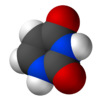Uracil in DNA
 |
|||
|
|
|||
| Names | |||
|---|---|---|---|
|
IUPAC name
Pyrimidine-2,4(1H,3H)-dione
|
|||
| Other names
2-oxy-4-oxy pyrimidine,
2,4(1H,3H)-pyrimidinedione, 2,4-dihydroxypyrimidine, 2,4-pyrimidinediol |
|||
| Identifiers | |||
|
3D model (Jmol)
|
|||
| ChEBI | |||
| ChemSpider | |||
| ECHA InfoCard | 100.000.565 | ||
| RTECS number | YQ8650000 | ||
| UNII | |||
|
|||
|
|||
| Properties | |||
| C4H4N2O2 | |||
| Molar mass | 112.08676 g/mol | ||
| Appearance | Solid | ||
| Density | 1.32 g/cm3 | ||
| Melting point | 335 °C (635 °F; 608 K) | ||
| Boiling point | N/A - decomposes | ||
| Soluble | |||
| Hazards | |||
| Main hazards | carcinogen and teratogen with chronic exposure | ||
| NFPA 704 | |||
| Flash point | Non-flammable | ||
| Related compounds | |||
|
Related compounds
|
Thymine Cytosine |
||
|
Except where otherwise noted, data are given for materials in their standard state (at 25 °C [77 °F], 100 kPa).
|
|||
|
|
|||
| Infobox references | |||
Uracil /ˈjʊərəsɪl/ (U) is one of the four nucleobases in the nucleic acid of RNA that are represented by the letters A, G, C and U. The others are adenine (A), cytosine (C), and guanine (G). In RNA, uracil binds to adenine via two hydrogen bonds. In DNA, the uracil nucleobase is replaced by thymine. Uracil is a demethylated form of thymine.
Uracil is a common and naturally occurring pyrimidine derivative. The name "uracil" was coined in 1885 by the German chemist Robert Behrend, who was attempting to synthesize derivatives of uric acid. Originally discovered in 1900 by Alberto Ascoli, it was isolated by hydrolysis of yeast nuclein; it was also found in bovine thymus and spleen, herring sperm, and wheat germ. It is a planar, unsaturated compound that has the ability to absorb light.
Based on 12C/13C isotopic ratios of organic compounds found in the Murchison meteorite, it is believed that uracil, xanthine and related molecules can also be formed extraterrestrially.
...
Wikipedia



